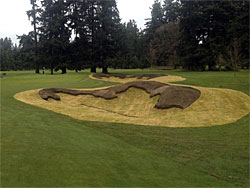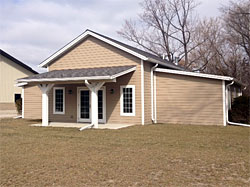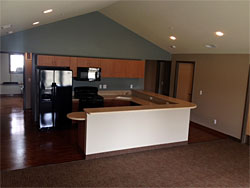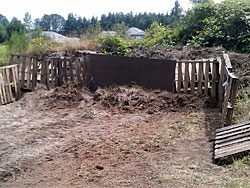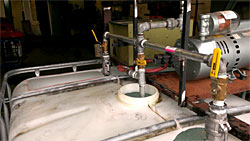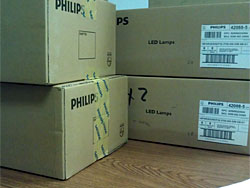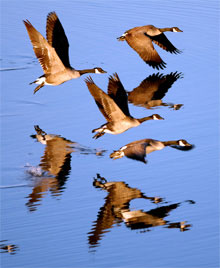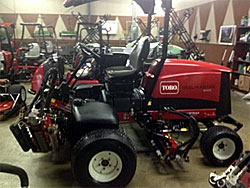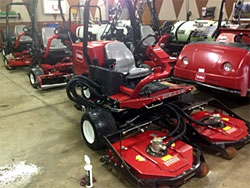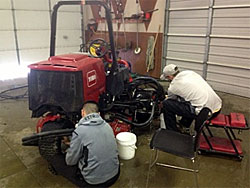|
 |
February 26, 2013 |
|
Is that dead grass? Joel Kachmarek, Tacoma Country and Golf Club, Lakewood, WA:
 "We started getting sod again this week and NO, it is not dead. This turf is just in a winter slumber. Remember our sod source for this project is a farm in eastern Washington. Why? Because the price is right... and they're the only farm growing the fescue blend we need for the bunker eyebrows. |
 |
|
New Intern Housing... Kevin Peck, asst supt, Country Club of Detroit, Grosse Pointe, MI:
"New this year is a dorm style house for students that are completing internships for their college degree. The dorm is capable of housing six students completing a professional internship as a requirement for their degree in higher education. These interns will come with an interest in various areas of private club management: golf course maintenance, inside management, cullinary, tennis, and future golf professionals. The dorm consists of a full kitchen, six bedrooms, two bathrooms, and a common area. |
 |
|
The Green Approach... Justin Ruiz, CGCS MG, Indian Summer Golf & Country Club, Olympia, WA:  "We have made some pretty big advancements in our efforts to become a little more environmental friendly. The side effects of our efforts have been some real money savings. The past challenges of the economy has made everyone look at their spending. Sometimes it is easy to look over the reoccurring expenses like electricity and gas and try to reduce spending elsewhere. My General Manager Trish and I took a look at those so called "constants" and figured out a way to save.
My team has been working on a large scale compost pile to manage our waste on the course. We have expanded our efforts and are now composting all of the fresh kitchen waste as well. We are composting the waste and then planning to re-use the compost when we plant annuals in the spring and summer months. We are also building a compost tea brewer to offset or potentially replace our fairway fertilizer program through the season. The savings is not calculated fully, but the potential is a healthy savings in our waste disposal and fertilizer budget.
Our mechanic, Geoff, is looking into converting the diesel equipment into burning used vegetable oil. At $4 plus dollars per gallon this could be a huge savings in fuel costs. He has also started looking at getting a used oil heater to heat the shop rather than relying on the propane heat we currently use. The savings would be from reduction in propane usage and eliminating the cost of waste oil recycling.
My first challenge was to match the lumen output of the bulbs. We have over a hundred 90watt flood lights that light the banquet rooms, restaurant and lounge. They do a good job lighting the rooms and the highest output LED bulbs weren't rated quite as high in lumen output. I bought one bulb to compare in our banquet room with the same color and it turned out to look actually brighter. |
 |
|
Let the Melting Begin... Slowly Chris Tritabaugh, Hazeltine National Golf Club, Chaska, MN: 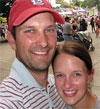 "As we prepare to turn the calendar to March, golfers in Minnesota start to think about green grass and golf course openings. Case in point: on my way home from work I drive past the Golf Zone indoor range in Shakopee. The number of cars in the lot is increasing by the day. 
Another one of the many reasons we strive for bentgrass playing surfaces is bentgrass' ability to hold onto dormancy and thereby withstand early freeze thaw events. Poa annua is very easily tricked into coming out of dormancy at this time of the winter. Free water, running over the top of Poa will wake the plant from dormancy. When this happens the plant begins to take up water; leaving plant cells susceptible to freeze injury. Bentgrass on the other-hand has a much stronger dormancy. Free water running over bentgrass at this time of the year generally does not break bentgrass dormancy, thereby keeping bentgrass less susceptible to freeze thaw injury during the the late winter and very early spring. |
 |
|
Sustainability vs. Social Conventions... Michael Stachowicz, Turf Specialist for the National Park Service, National Mall and Memorial Parks, Washington, DC:  "If the sustainability movement on golf courses ever had a real chance of becoming the industry norm, it would have been now. In the past decade, the popularity of links courses have skyrocketed, the USGA has started their 'brown is the new green' education campaign, the top of the top 100 lists are dominated by links traditional courses, grounds budgets have been cut (bringing into question economic sustainability in addition to environmental sustainability), and the internet has allowed for information exchange and education on this to be spread quickly throughout the industry.
Why has it been so difficult to make headway on this? In fact, there are many private clubs who have doubled down on high cost maintenance despite declining interest in memberships. The past two decades, with all the successes of the minimalist architects and courses that have gone back to their historical roots, have not translated into a new standard of maintenance for the vast majority of courses. Expectations have not adjusted, even with budgets getting cut. Sustainable continues to be what it has been for two decades... an Audubon membership.
It is important to understand what role culture plays, forcing us to keep our landscapes simple and within convention. There are two types of landscapes that touch us as humans; one that offers exploration (golf courses, trails, parks) and the other is one that is manageable, understandable or orderly. The American neighborhood and yard are meant to be the latter. People believe that a yard should look a certain way. It is difficult to break away from this convention for social reasons, as people tend to create landscapes around their home that their neighbors would approve of. This cultural dynamic tends to create a homogenous landscape... this is why the ideal lawn looks ideal no matter what part of the country in which it exists. A healthy environment is not nearly as valued in our society as wealth, neatness, and safety.
discovered), all while being understandable: both coherent (orderly) and legible (accessible to finding one's way). Golf courses offer a landscape that is understandable, coherent, and legible (one knows to travel from tee to fairway to green) through the routing of holes. Golf courses give millions of people the opportunity to travel through landscapes that are dynamic (mountains, desert, dunes, forests) but in a familiar way (tee to fairway to green, repeat). It is an expedition into the wilderness, but with training wheels... it is mysterious and wild, while being safe. It seems that a golf course is a great way to change people's perspective on what is a socially acceptable landscape. Unfortunately, so far golf courses have done it in way that includes unrelenting emerald green, forest ecosystems with no understory, unnaturally clean ponds with fountains, and perfect fescues that do not reflect any local fauna.
into the property. But this means golf course memberships and clientele need to start valuing ecology over wealth and status. Right now that is what golf courses and greenkeepers are hostage to... egos. Landscapes can be a result of culture and landscapes can affect culture... golf courses have been through both. Golf courses as landscape icons used to be in the position to decide what is cool and valuable, but they may be losing that, which is not good for any of us who care about the environment, golf culture, and the health of the game." |
 |
|
Geese... Steve Cook, CGCS MG, Oakland Hills Country Club, Bloomfield Hills, MI:
 "Geese will choose a mate when they are about three years old and will stay monogamous for life, raising new families together each year. If one mate dies, the other mate will sometimes wait several years before choosing a new partner or might even stay single.
The female goose will build a nest and line it with down plucked from her body. She will lay one egg each day until the full clutch of about 5 eggs is obtained. After all the eggs are laid, she will sit on her nest to incubate the eggs, which takes about 28-30 days. |
 |
|
Looking like new again! Gary Myers, CGCS, The Sagamore Club, Noblesville, IN:
 "Every year at this time we begin the cleaning process of all turf equipment. Two of our greatest assets are our staff and our equipment. Without these two items working at peak efficiency we could not operate at the level that we demand.
Visit Gary's blog at sagamoreturfgrass.blogspot.com. |
|
More good looking blogs! Another busy week for the TurfNet Blog Makeover Department! Have a blog? Let us help you put your best foott forward with a new blog theme and custom header. These blogs have new facelifts courtesy of TurfNet:    Want one? They're free, but ya gotta be a TurfNet member to get one! Contact us. |
 |
|
About our Blog Aggregator: Many superintendents are now hosting private blogs to better communicate with their golfers and/or members. Beyond local weather and course conditions, there is a great deal of information about projects, methodologies and techniques that would be of value to other superintendents — hence our Turf Blog Aggregator. As every blogger struggles occasionally with content, we also include posts intended to educate golfers about turf maintenance for others to use as a template for their own blogs. Miss any previous issues of TBA? You can find them all here. |
